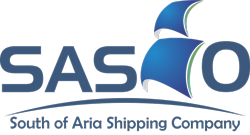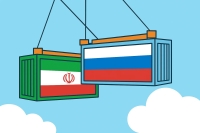Which Countries Use Iran as the Main Route to Ship to Russia?
Here's an overview of countries that use Iran as the main route to ship to Russia, incorporating rail, road, and sea links.
Gulf and Middle Eastern Countries in Shipping from Iran to Russia
This group includes the United Arab Emirates, Oman, Qatar, Kuwait, Bahrain, and Saudi Arabia. While not formal INSTC members, these nations utilize southern Iranian ports like Bandar Abbas, Bushehr, and Chabahar for Sea freight Iran to Russia, especially when alternative paths are disrupted by sanctions or conflicts.
For instance, the UAE and Oman rely on Chabahar for access to Central Asia and onward Container shipping from Iran to Russia, while Saudi Arabia occasionally transits goods through Iran. Political relations and regional rivalries limit widespread use, but interest in INSTC for shipping from Iran to Russia has grown in 2024-2025.
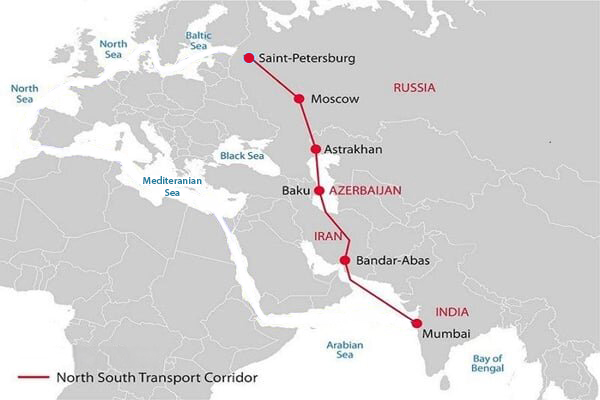
Indian Subcontinent Countries in Shipping from Iran to Russia
Encompassing India and Pakistan, this region actively engages in shipping from Iran to Russia via INSTC. India, a founding member, ships goods from Mumbai to Chabahar or Bandar Abbas, then overland or by rail to northern Iranian ports like Anzali and Astara, before crossing the Caspian Sea for final shipping from Iran to Russia. This cuts transit time from 40 days to about 20-25 days. Pakistan, though not an official member, shows potential for integration with the China-Pakistan Economic Corridor (CPEC), with discussions in 2025 aiming to link it to INSTC for enhanced shipping from Iran to Russia (valdaiclub).
Central Asian Countries in Shipping from Iran to Russia
Including Kazakhstan, Turkmenistan, Kyrgyzstan, Uzbekistan, and Tajikistan, these landlocked nations depend on Iran's territory for shipping Russia due to limited sea access. The Kazakhstan-Turkmenistan-Iran railway (operational since 2014) connects goods to southern Iranian ports and facilitates northward shipping from Iran to Russia via Caspian ports. Kazakhstan and Turkmenistan play pivotal roles, with INSTC boosting trade efficiency for shipping from Iran to Russia and to India (artarail & valdaiclub).
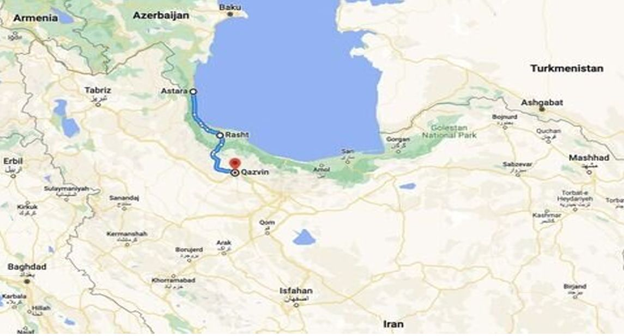
The route of the Ghazvin- Rasht–Astara Railway
South Caucasus Countries in Shipping from Iran to Russia
This includes Azerbaijan, Armenia, and Georgia. Azerbaijan, an active INSTC participant, advances projects like the Astara-Rasht-Qazvin railway to streamline shipping from Iran to Russia. Armenia is planning an Armenia-Iran rail link to connect with INSTC, though progress is gradual. Georgia has less direct involvement but benefits from Caucasus routes for access during disruptions like the Ukraine tensions, positioning Iran as a key bridge for shipping from Iran to Russia.
China and Turkey in Shipping from Iran to Russia
Covering western China and Turkey, these nations tap into Iran's routes for alternative shipping from Iran to Russia. China, not a formal INSTC member, expresses interest in aligning it with the Belt and Road Initiative (BRI), allowing cargo from Central Asia to pass through Iran for faster shipping from Iran to Russia. In 2025, Iran hosted Chinese officials for rail discussions. Turkey uses Iranian paths over the Black Sea route less commonly, but the revived Iran-Turkey-Pakistan (ITI) rail corridor in 2025 supports potential integration with INSTC for shipping from Iran to Russia (artarail & valdaiclub).
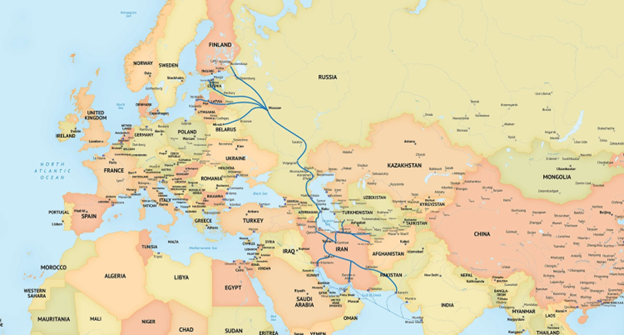
The International North-South Transport Corridor
Transit Routes for Shipping from Iran to Russia
The transit routes for shipping from Iran to Russia are primarily part of the International North–South Transport Corridor (INSTC), a multimodal network that integrates sea, rail, and road transport for goods and passengers. Spanning approximately 7,200 kilometers, the corridor begins in South Asia (such as India), passes through Iran, and extends to Russia and Europe. Its main objective is to reduce transit time and costs—by up to 40% shorter and 30% cheaper compared to the Suez Canal—making it an essential trade link, particularly under the pressure of Western sanctions. The INSTC relies on key ports such as Bandar Abbas, Chabahar, Anzali, and Astara in Iran and Astrakhan in Russia. These routes are vital for transit trade from southern countries to Russia, and they have already increased bilateral trade volumes to over USD 70 billion annually.
Thanks to these advantages, the INSTC has become one of the most important transit route Iran Russia options, offering exporters and logistics providers significant savings while boosting the competitiveness of regional supply chains. For businesses engaged in Iran to Russia logistics and seeking reliable solutions for freight to Russia, understanding the structure of its main branches is crucial.
1. Western Branch of the INSTC (Azerbaijan Route)
This is the most important overland route from Iran to Russia, running through Azerbaijan. Goods enter through Iran southern ports such as Bandar Abbas or Chabahar, continue by rail along the Qazvin–Rasht–Astara railway, and reach the Astara border. From there, shipments cross Azerbaijan and move onward to Russia. Part of this rail connection (Rasht–Astara) is still under construction, with Russia actively co-financing the project, highlighting the strategic value of this corridor.
2. Eastern Branch of the INSTC (Central Asia Route)
The eastern route runs through eastern Iran and links directly to Central Asian countries. From Iran, goods are transported into Turkmenistan and Kazakhstan, and then forwarded to Russia. The Kazakhstan–Turkmenistan–Iran railway is the backbone of this corridor. Connected to Persian Gulf ports, this branch promotes transport between Central Asia and the Gulf region. It is especially vital for landlocked states seeking dependable access to Russian markets.
3. Central Branch of the INSTC (Caspian Sea Route)
The central branch is a multimodal, sea-based route that crosses the Caspian Sea. Goods are shipped from northern Iranian ports such as Anzali and Astara to Russian ports like Astrakhan. This maritime route is integrated with Iran’s southern rail connections (for example, from Bandar Abbas to Anzali), allowing flexible logistics solutions. Plans have been proposed to establish a consortium of ports and shipping companies to strengthen this corridor and expand its capacity.
Together, these three routes facilitate trade across 14 countries, from Northwestern Europe to Southeast Asia, while ensuring faster, cheaper, and more reliable shipping from Iran to Russia.
What Are the Top 10 Imports of Russia?
Based on international trade statistics on Worldstopexports, these are the main categories of goods imported by Russia:
|
Rank |
Product Category |
Import Value |
Share (%) |
Explanation |
|
1 |
Machinery incl. computers |
$37B |
18.1% |
Largest import group, includes computers, heavy machinery, pumps, air conditioners. Miscellaneous machinery (+38.1%) and air conditioners (+15.4%) saw the biggest growth. |
|
2 |
Vehicles |
$29.3B |
14.3% |
Cars ($17.3B, +15%) dominate, plus parts, trucks, tractors, motorcycles (+33.4%). Despite sanctions, demand remains high. |
|
3 |
Electrical machinery, equipment |
$20.5B |
10.1% |
Covers smartphones, telecom equipment. Declined -19.9% vs 2023. Still essential for consumer and industrial use. |
|
4 |
Pharmaceuticals |
$12.4B |
6.1% |
Mainly packaged medicines, reflecting reliance on foreign drug supply. |
|
5 |
Plastics, articles |
$7.5B |
3.7% |
Includes plastic resins and finished products. Imports dropped -9.4% in 2024. |
|
6 |
Optical, technical, medical apparatus |
$7B |
3.4% |
Includes precision instruments, diagnostic devices, medical equipment. Vital for the healthcare sector. |
|
7 |
Organic chemicals |
$5.1B |
2.5% |
Stable demand, small increase (+1%). Used in pharma, plastics, and industry. |
|
8 |
Inorganic chemicals |
$4.7B |
2.3% |
Strongest growth (+18.4%), showing industrial reliance. |
|
9 |
Fruits, nuts |
$4.1B |
2.0% |
Imports fell -11.7%. Tropical fruits not produced locally remain in demand. |
|
10 |
Knit/crochet clothing, accessories |
$4B |
2.0% |
Includes sweaters, pullovers, accessories. Fashion imports remain steady. |
Customs Regulations and Import Duties in Russia
Russia's customs regulations are overseen by the Federal Customs Service (FCS), which mandates electronic declarations through the PDF of Unified Automated Information System (UAIS) for all commercial imports. The clearance process typically spans 2-5 days and includes temporary storage in bonded warehouses, document scrutiny, risk evaluation, and selective physical inspections. Essential documents comprise:
- commercial invoices
- packing lists
- sales contracts
- transport papers like bills of lading
- specialized certificates such as the Eurasian Conformity (EAC) mark for regulated products
All submissions must be in Russian or accompanied by certified translations (tonlexing)
Import duties are levied on the CIF value (cost of goods + insurance + freight), with rates ranging from 0% to 20% based on Harmonized System (HS) codes—for instance, 5-15% on consumer goods and electronics. In response to geopolitical tensions, duties for imports from "unfriendly" nations (e.g., US, EU) have escalated: 35% on personal care items, 50% on wood and wallpaper, and from January 2025, further hikes averaging 10% on beverages, sauces, pasta, and meat products (tonlexing).
Value-Added Tax (VAT) stands at 20% on the total dutiable amount (CIF + duties), reduced to 10% for pharmaceuticals and foodstuffs. Excise duties vary for luxury items like alcohol, tobacco, fuels, and automobiles. Prohibited or restricted goods—such as weapons, narcotics, and endangered species—demand prior permits. Personal parcels qualify for duty-free entry up to €200 in value and 31 kg per month, with 15% duties on excesses.
As a strategic ally, Iran benefits from the 2025 EAEU-Iran Free Trade Agreement, which eliminates tariffs on approximately 87% of goods imported to Russia. Additionally, the International North–South Transport Corridor (INSTC) facilitates smoother trade flows by providing efficient multimodal transport routes. Together, these factors reduce barriers, lower costs, and shorten transit times, enhancing bilateral commerce and creating new opportunities for exporters targeting the Russian market (tehrantimes)
Modes of Shipping from Iran to Russia
Shipping from Iran to Russia involves multiple transport modes, each offering distinct advantages depending on the type of cargo, urgency, and cost considerations. The most common methods include road transport, rail freight, and sea freight, often combined in multimodal logistics solutions to optimize efficiency.
Road transport from Iran to Russia is widely used for regional shipments and smaller consignments. It offers flexibility in routing and door-to-door delivery but may face delays at border crossings due to customs inspections or geopolitical restrictions.
Rail shipping forms the backbone of major trade flows, particularly through the Qazvin-Rasht-Astara railway (under construction) and the Kazakhstan-Turkmenistan-Iran corridor. Rail is faster and more cost-effective than road for bulk cargo, ensuring reliable delivery times while supporting container shipping (FCL / LCL) to Russia.
Sea freight from northern Iranian ports like Anzali and Astara across the Caspian Sea is another key option. This method enables high-volume transport and connects directly to Russian ports such as Astrakhan. Combining sea and rail transport allows exporters to reduce transit time and costs significantly.
Choosing the right mode depends on cargo type, budget, and urgency. For traders and logistics providers, understanding the strengths and limitations of each method is critical to ensuring smooth, timely, and cost-efficient delivery. Effective planning in Iran to Russia logistics can enhance supply chain reliability and optimize freight operations.
"For more information on shipping from Iran, read our guides: Overview of Freight Forwarding in Iran and Transport and Shipment to/from Iran."
Iran Russia Shipping Company
For businesses seeking reliable logistics solutions, choosing the right Iran Russia shipping company is crucial. SASCO stands out as a trusted partner for transporting goods between Iran and Russia, offering seamless services across sea, rail, and road routes. Leveraging Iran’s strategic location along the International North–South Transport Corridor (INSTC), SASCO ensures faster transit times, competitive freight rates, and full compliance with customs regulations.
Whether you are exporting from Iran or transiting goods from third countries, SASCO’s Iran-to-Russia transport services provide end-to-end support, including container shipping (FCL/LCL), cargo tracking, and freight forwarding. By partnering with SASCO, businesses gain a competitive edge in the Russian market, optimizing supply chains while reducing costs and risks. Make your Iran-to-Russia shipments efficient, reliable, and strategically aligned with regional trade opportunities.
FAQs
Q1: What are the freight rates from Iran to Russia?
A1: Shipping cost Iran to Russia varies by cargo type, volume, and shipping method, typically ranging from $800 to $2,500 per container (FCL) depending on the route and service.
Q2: What is the transit time from Iran to Russia?
A2: Transit time depends on the route and mode: via INSTC rail/road, it usually takes 15–25 days; via Caspian Sea routes, 20–30 days.
